I may receive a commission if you purchase through links in this post. I am not a doctor; please consult your practitioner before changing your supplement or healthcare regimen.
Gluten-free Rice Bread makes wonderful sandwich bread or toast, great with or for any meal of the day, a versatile loaf that’s easy to make! While most gluten-free breads combine rice flour with potato-derived flours (like tapioca and potato starch), this recipe is more allergy-friendly — also free of yeast and gums.
Gluten-free Rice Bread is low oxalate and low salicylate.
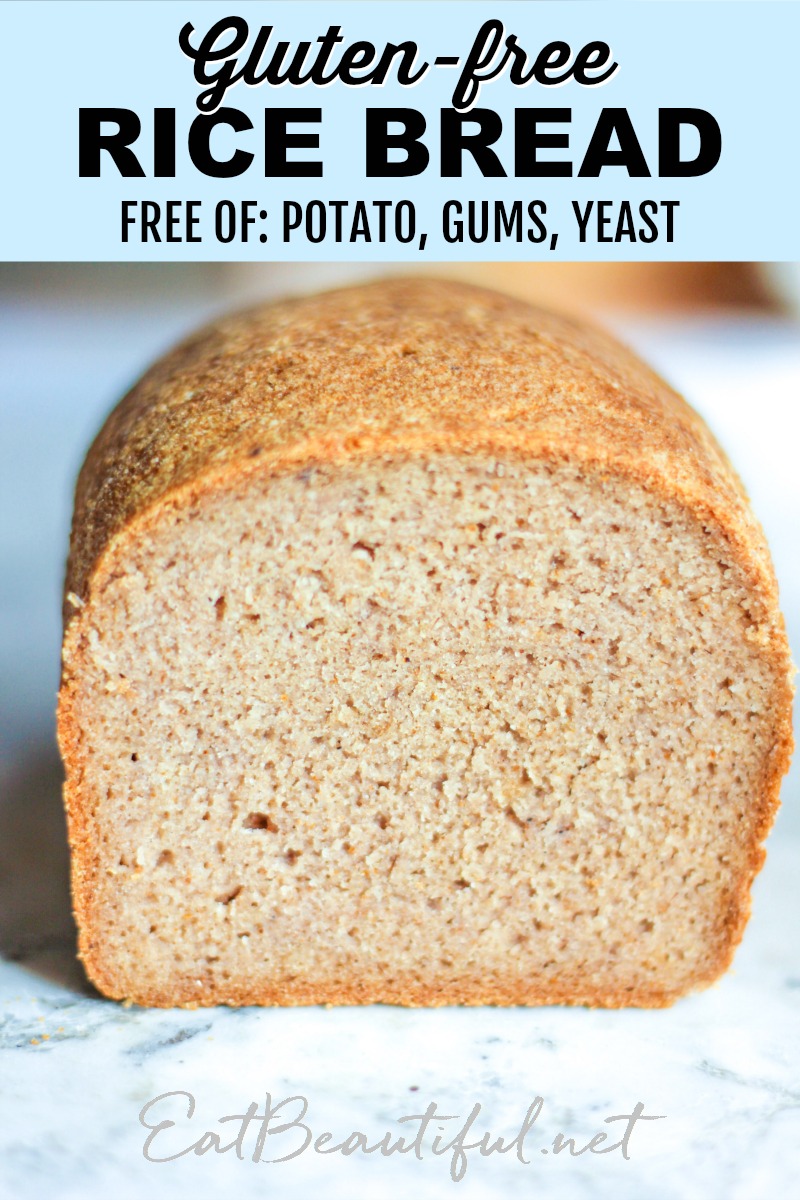
In addition to being gluten-free, this recipe is also appropriate for Paleo folks who eat white rice and the VAD diet.
For extra sensitive digestion, you can also make the Sourdough Gluten-free Rice Bread variation below.
Potato-free Easy Gluten-free Rice Bread
Easy Gluten-free Rice Bread is free of yeast, dairy (optional), refined sugar, refined oil and potato! No: potato starch, arrowroot, tapioca or cassava (all in the potato family). And no gums! No xanthan gum, because it’s problematic for some people and not safe for babies.
Most gluten-free bread loaves (and gluten-free flour mixes) combine rice flour with tapioca or potato flour, but roughly half of the population does not digest potatoes and grains well when eaten together. This recipe uses rice flour alone to create a truly delicious, gentle-to-digest slicing bread for sandwiches, toast or any of your bread needs. Only healthy, real food ingredients!
Nightshade-free
While I personally enjoy potatoes, the other advantage of keeping potato starch out of rice bread recipes is: This recipe is nightshade-free. For those who get inflammation from potatoes, this recipe is safe.
(And most potato starch on the market is sourced conventionally; potatoes belong to the list of Dirty Dozen produce items — that are full of pesticide residues and should only be consumed organic. So all that conventionally grown gluten-free bread … not so good.)
Ingredients in Easy Gluten-free Rice Bread
Easy Gluten-free Rice Bread is mixed just like a loaf of “quick bread”, no yeast or waiting for it to rise.
The ingredients you’ll need are:
White rice flour — This great pantry staple yields a tender loaf and even provides healthy carbs and resistant starch. (I don’t use brown rice flour because it’s harder to digest … which means our bodies can’t access the nutrition.)
Psyllium husk powder — Psyllium husk grows worldwide and comes from a shrub-like herb called Plantago ovata. Each plant produces over 10,000 tiny seeds. Psyllium husk powder is a soluble fiber made from the husks of the seeds — that helps with regularity and is prebiotic. PHP is often used in Keto baking because it has zero net carbs and helps to create a light, nice bread texture!
That’s why I use it here: Psyllium husk powder is a great alternative to other flours that are harder to digest, and it’s naturally gluten-free.
The remaining ingredients in Easy Gluten-free Rice Bread are:
- Water — The recipe calls for 1-1/2 cups of water. To measure the water, use a liquid measuring cup. Water temperature is key to this recipe because it keeps the solid fat warm (instead of congealing) but isn’t too hot (which isn’t good for the eggs or baking soda).
- Coconut oil or butter — If you’re dairy-free, choose coconut oil. Otherwise, I like to use Kerrygold butter. Solid melted fat adds moisture to this bread and helps to create the right “crumb”. (Use butter for low oxalate and low salicylate.)
- Granulated sweetener — Unrefined sugar options add moisture, help to create the right crumb … and add a subtle balancing of flavor, as opposed to true sweetness. I recommend using coconut or maple sugar because they’re unrefined. (Choose maple for low oxalate and low salicylate.)
- Egg whites — No egg yolks are used in this recipe. Egg whites help to create the right rise in the bread, add moisture, as well as holding the bread together with a spongey texture — in the absence of gluten. You won’t taste any eggy flavor with this bread.
- Gelatin — In addition to providing needed amino acids to our diet, gelatin has good binding properties for a gluten-free bread in the absence of a starchy flour.
- Baking soda — This leavening agent is used for the bread’s rise.
- And sea salt — For just the right flavor.
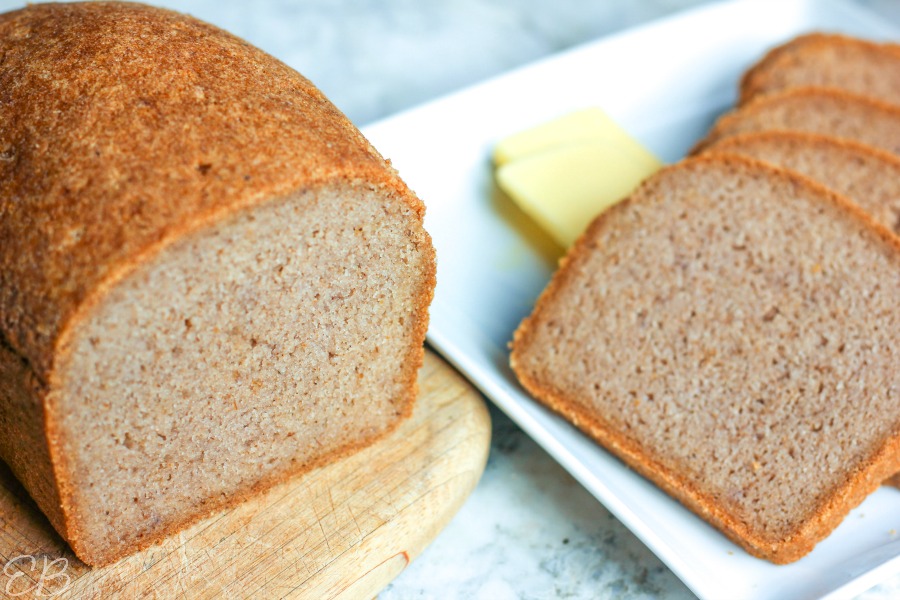
Measuring dry ingredients
I know most of you do not want to weigh your flour, and I don’t want to either. I’m a busy lady, and I bake daily, so I don’t want to eye a scale. I want my recipes to work with a simple measuring cup system.
If you also prefer to use measuring cups and spoons, that’s great. While some claim that it doesn’t work as well, I disagree. If you take care when measuring your ingredients, most gluten-free recipes do not need to be weighed, especially for small batch home cooking.
So, good news! This recipe is not finicky! Just use your trusty measuring cups. Don’t worry about doing everything perfectly, and you’ll be so happy with this easy, terrific loaf of bread.
Here’s how to measure ingredients with a dry measure:
1. Select a set of metal nested measuring cups (like these.)
2. Spoon flour into the cup, and overfill slightly.
3. Level the cup with something straight, like the back of a straight butter knife.
Note: Don’t confuse nested measuring cups with a liquid measuring cup. You don’t want to measure dry ingredients in a liquid measuring cup.
How to mix the dough and shape the loaf
This dough comes together really easily. No dough hook or electric beaters are needed. In fact, I just use a fork to mix my ingredients.
Then I grab a rubber spatula and roll the dough in the bowl until a loaf shape is created with a rounded, smooth surface.
This I roll into my prepared loaf pan (simply lined with a strip of parchment paper so the finished loaf is easy to pull out). Then I briefly shape the dough a bit further with lightly wetted fingers, so the loaf is taller in the center and slopes down on the sides.
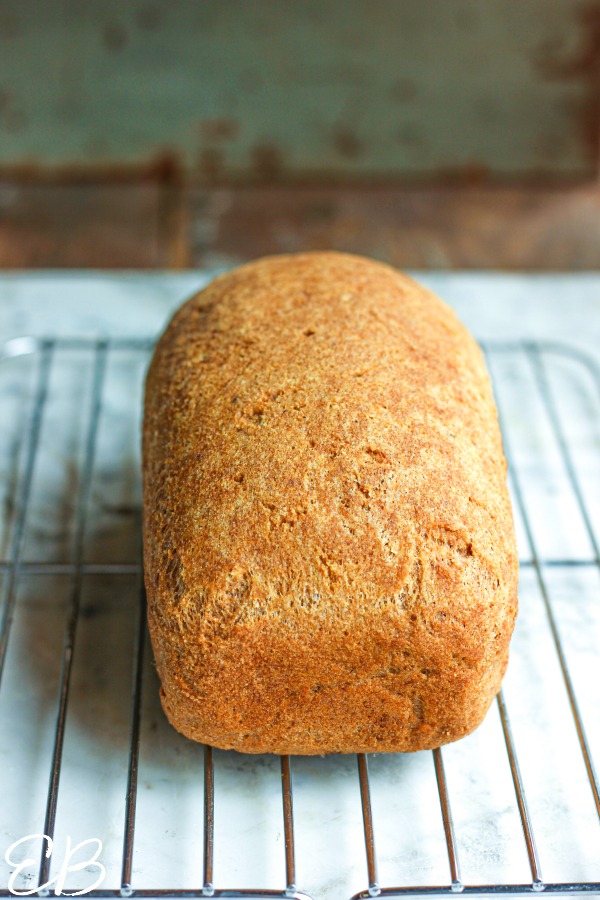
Which loaf pan to use
There are two reasons why it’s good to consider or reconsider your loaf pan: the first is the size of the pan, and the second is what material the pan is made of. I get this question a lot: What pan did you use to bake that loaf of bread?
Tip: Choose to use a slightly smaller loaf pan when making sandwich-style bread loaves, if you want your loaf to be tall.
While I could just make a bigger recipe to fit a bigger pan, I don’t increase the ingredients because I need the bread to cook through to the center without the exterior getting too dark.
For this reason, I don’t bake with a traditional 9×5 inch loaf pan. I choose an 8-1/2″ by 4-1/2″ by 2-3/4″ loaf pan. Be sure to use this smaller pan size if you want your loaf to rise higher instead of being lower and broader.
Pan material
Aluminized steel works well for bakers because aluminum conducts heat really well. And aluminum is perfectly safe to bake with as long as you’re not using acidic foods like lemon juice or tomatoes (which react with the metal). Here’s a good aluminized steel loaf pan.
Ceramic is a good option, too, used for millennia and a pleasure to use. Here’s a good ceramic loaf pan.
If you don’t want to invest in a new pan, no problem. Just be aware that when this bread is baked in a larger pan, it won’t rise as high.
Does this loaf need to rise before baking
Nope! This bread is as easy to make as a loaf of banana bread! There’s no yeast in this recipe, no need to wait for it to rise.
The baking soda creates a slight rise while the loaf bakes.
However, if you want to make this loaf extra gentle to digest or want the sour flavor, you can make this loaf into Sourdough Gluten-free Rice Bread. In this case, see the Recipe Notes below, where I walk you through the extra step. In my experience, most people do not need to ferment white rice; it’s already pretty gentle. But some people do! If that’s you, enjoy the sourdough version of this recipe.
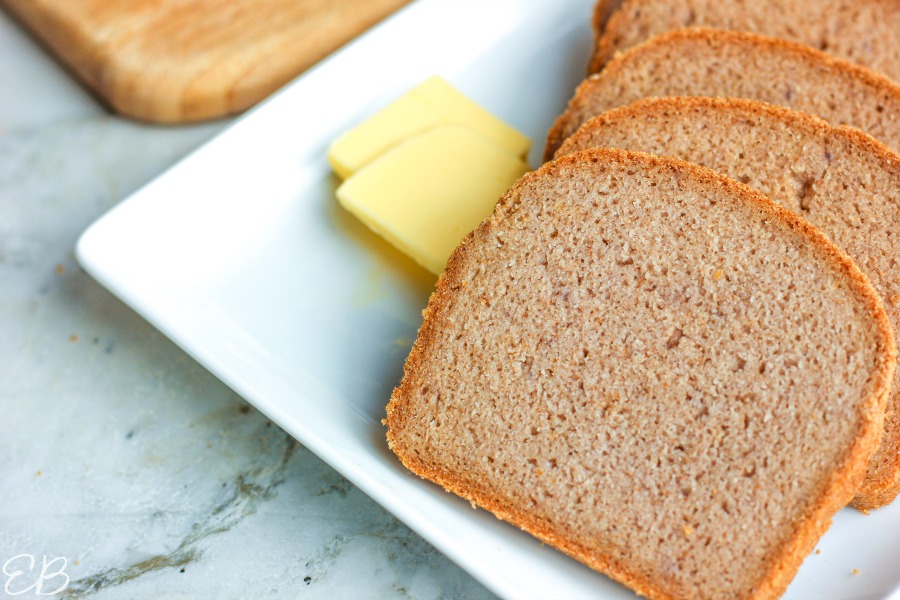
What’s Easy Gluten-free Rice Bread turn out like
When ready to serve the cooled, or mostly cooled loaf, use a serrated knife to slice it.
The crust on Easy Gluten-free Rice Bread is a little rustic and crusty — in a good way. It’s a nice thin crust, not hard or too tough, with a nice crunch.
The interior baked dough is spongey, tender and soft. However, it’s not lofty or fluffy … more like a half whole grain rustic loaf, a bit dense, mildly chewy and very enjoyable.
I actually love this bread plain, sliced thinly. You can slice into it about 20 minutes after it comes out of the oven! Warm and plain, I find it delicious!
Other ways to enjoy Easy Gluten-free Rice Bread:
- with butter and honey
- or nut butter and jam
- with meat and veggies
- or smashed avocado and garlic salt
- with melted cheese
- and on and on … anyway you’d use sandwich bread or toast!
Why to buy organic white rice flour for baking bread
It’s common these days to buy brown rice flour — and to buy conventional flour — so why buy organic white rice flour?
Organic rice paddies make a measurable difference in the healthfulness of rice products.
Did you know? Conventional rice production uses over forty different pesticides to control weeds and insects — while organic production supports research on methods for decreasing levels of arsenic in organic rice.
Why eat white rice instead of brown rice? Hard to digest, whole grains’ nutrients are locked in unless released through a form of pre-digestion like the sourdough process. Also, when tested, brown rice is consistently higher in inorganic arsenic content than white rice. (source)
So surprisingly, white rice is actually healthier than brown rice! You can read more in this recipe post — why white rice is now considered healthy and even Paleo.
Honestly, it is hard to find white rice flour that’s organic. Many stores do not carry it. You can buy a few bags at a time here.
How to store Easy Gluten-free Rice Bread
Like a good artisanal loaf, you can actually leave this bread out on the counter for up to 24 hours! I just flip the cut side down on the cutting board or a plate, so the exposed middle doesn’t dry out when exposed to the air. If you happen to pull this loaf out of the oven in the evening, just leave it out until morning, then enjoy all day or wrap it.
To store, wrap in any airtight container, and store on the counter.
I don’t recommend refrigerating this bread, because it contains gelatin, so chilled, the bread’s texture will change.
To freeze for longer term storage, pre-slice the bread. Then freeze for 30 to 60 minutes so slices stay separate. Then wrap and freeze for up to 3 months. To eat, just pop off the number of slices you need, and toast or warm gently.
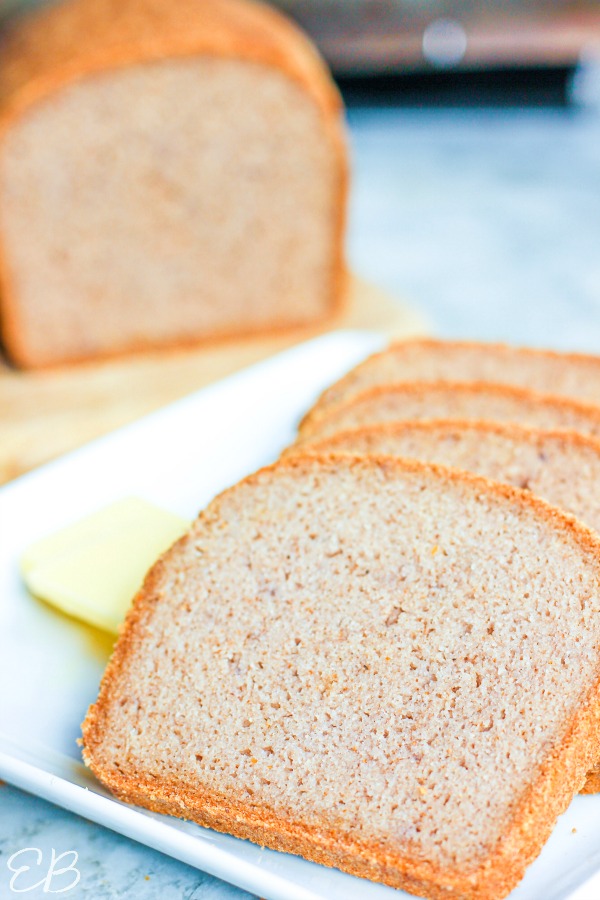
Easy Gluten-free Rice Bread (No potato, gums or yeast)
Equipment
- loaf pan
- oven
Ingredients
- 2 cups rice flour (white rice flour for easy digestion; see link)
- 1-½ cups water , warm (not hot) (Sourdough option: omit ¼ cup of the water, and replace it with sauerkraut juice or whey. See Recipe Notes for variation.)
- ¼ cup butter or coconut oil, melted and cooled; avocado oil may be fine too
- ¼ cup psyllium husk powder (needs to be husk powder; or put husks into coffee grinder, then measure powder)
- 2 Tablespoons maple sugar or coconut sugar (or other granulated sweetener you use)
- 2 Tablespoons gelatin (see link for sustainable brand and use code BEAUTIFUL10 at check out for 10% off your entire order)
- 2 egg whites
- ½ teaspoon baking soda , sifted
- ½ teaspoon sea salt
Instructions
- Preheat oven to 350 degrees Fahrenheit. Grease loaf pan and line with one strip of parchment paper, to make it easy to pull out/remove baked loaf.
- In large mixing bowl, combine dry ingredients: rice flour, psyllium husk powder, sweetener, gelatin, baking soda and sea salt.
- In medium bowl, combine liquid ingredients: warm water, fat of choice and egg whites. (If making sourdough version, use only 1-¼ cups water, and sub in the remaining liquid [¼ cup] with sauerkraut juice or whey.)
- Add liquid ingredients to dry ingredients and mix well. Electric beaters may be used. (Do not over-mix.) Roll dough into a giant jelly roll shape in bowl. Roll batter into prepared loaf pan, and shape the top with spatula or wetted fingers, so it's slightly mounded in the middle.
- Bake approximately 1 hour, until loaf is well risen, very golden brown and sounds a bit hollow when tapped on the bottom side.

- Allow to cool briefly in pan. Then slide knife along each end to free from pan, and lift up on parchment ends to pull loaf out. Allow to cool on wire rack before slicing.
Notes
How to make Sourdough Gluten-free Rice Bread
You'll need either probiotic, living sauerkraut juice (or the probiotic liquid from another fermented vegetable) OR probiotic whey to make this recipe.- Proceed with the above recipe, as it is written, BUT sub ¼ cup sauerkraut juice or whey for ¼ cup of the water.
- After your loaf is formed, place it in a warm place for 4 hours. Then cover and place in the refrigerator overnight.
- In the morning, again, place loaf in warm location an additional 4 hours.
- Preheat oven, and bake as above recipe describes.
Nutrition
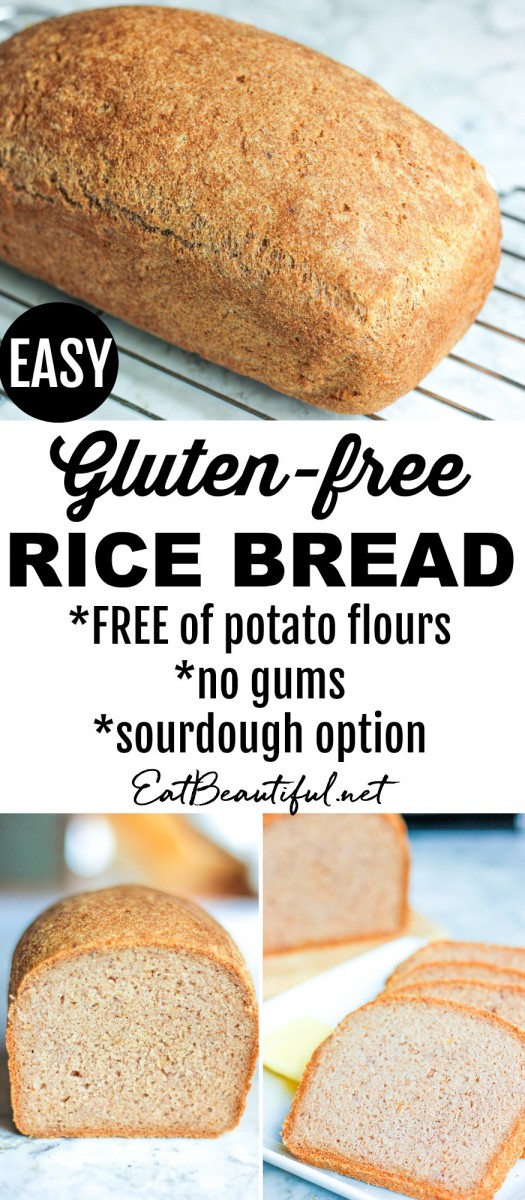
If you love gentle carbs, I think you’ll also love these recipes:
- Gluten-free, Vegan Oat Bread
- Oat Flour Cake (Vegan, Gluten-free)
- 2-Ingredient Rice Flour Porridge
- Paleo & AIP Cassava Flour Biscuits (egg-free)
- Best Easy AIP Bread Recipe (egg-free, nut-free)
- Paleo & AIP Sourdough Sandwich Bread (egg-free, nut-free)
- Paleo Sandwich Bread (nut-free, high protein)
- Paleo Overnight Healthy Chocolate Muffins (soaked)

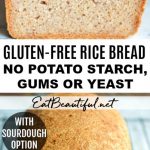
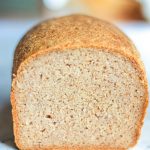
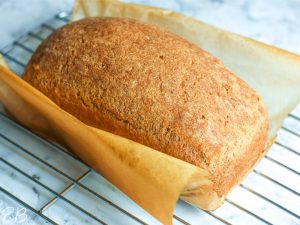

Chandra says
Recipe asks for gelatine, what can this be substituted for as I am a vegetrian.
Megan says
Hi Chandra, good question. I appreciate providing that option for vegetarian and vegan readers. If you can tolerate xanthan gum, that would be the easiest sub: use 1 to 1.5 teaspoons in place of the gelatin. Another option is to use 1 to 1.5 teaspoons Konjac powder. (Konjac powder is also known as Glucomannan powder; it is ground up konjac root, which has been used in Asia as a dietary fiber for centuries.) I haven’t used either of these options with this recipe, but base the amounts on common replacements in gluten-free baking. Let us know how your bread turns out if you make it using one of these subs. 🙂
Megan says
Here’s a good, non-GMO xanthan gum: https://amzn.to/36wHiYF
Here’s a good, non-GMO Konjac gum: https://amzn.to/2X51mhL
Dorothy says
I’m interested in the sourdough version of this recipe, which looks great, by the way. I tried the other sourdough recipe, the nut loaf one you sent out. My sauerkraut went bad after I removed some juice. Do you think apple cider vinegar could be subbed for the kraut juice?
Megan says
Hi Dorothy, yes, you can. You could use 2 T. ACV + 2 T. water to replace the 1/4 cup kraut juice. Another option is to use whey, which can be drained from non-dairy or dairy yogurt (and you’ll have Greek yogurt or yogurt cheese leftover to enjoy). I haven’t had that happen with my sauerkraut, and I’m sorry it happened to yours! If you use kraut juice in the future, you can replace it by making a saltwater solution (new brine) and pouring it over your kraut. (The ratio would be 1 cup water to 1.5 teaspoons sea salt.) I’m glad this bread recipe looks good! I hope you enjoy making and eating it! 🙂
Dorothy says
Hi Megan, that answer is appreciated….I’m late in seeing it. I wonder if the sugar is necessary for getting the right consistency. Do you think it would possibly work well to leave it out?
Megan says
Dorothy, I don’t think I tried this recipe without, so I’d love to hear how it goes if you try it that way. Typically, I like the results better with a little sweetener, texture-wise, but it may be fine.
Dorothy says
Ok thanks, I may give it a try.
Megan says
Great. 🙂
Carrie says
Hi Megan,
So excited to try this bread! I remember you sharing that one of your sons has an egg intolerance, and so do I (testing through Dr. Zeff). I’m not sure if my intolerance is to both the yolks and whites, but have avoided entirely for a few years now. I sorely miss them! With this recipe calling for just the whites (we’re doing the VAD diet and appreciate these recipes), would there potentially be a substitute for the whites, so that I could indulge occasionally, too? I’m hopeful! 😉
Additionally, I’ve been using Natural Grocers’ White Rice Flour (Non-GMO) when we make your ‘Rice Porridge’ recipe, but not sure that may be eliminating the arsenic (amid other contaminants), and defer to your research. I love all the information you include in your recipes. Many thanks for helping us!
Megan says
Hi Carrie! I’m sorry, the egg intolerance is “the worst”! 😉 Not really, but it’s a really hard one to have! Eggs are often hard to replace in recipes, especially without some experimenting. After you’ve been on the diet for a while, I think you’ll be able to have this egg-free bread recipe: https://eatbeautiful.net/paleo-aip-sourdough-sandwich-bread/ as my boys can both have it now, but that may be a year or more. Re this recipe, if you’re up for experimenting, here are some options: 1 T. flaxseed meal, 1 T. chia seed meal or 1 tsp psyllium husk powder stirred into and soaked in 3 T. of warm water can replace each egg. I don’t know how well it will work, but it may be worth a try if you don’t mind eating an imperfect result. You might need to tweak it a bit. But two eggs can be replaced in recipes. Let us know if you have success.
Yes, the non-GMO labeling at N.G. bothers me. I think it’s another form of green-washing, and that market does it quite a bit. Sigh. 😉
Many blessings and always happy to help! 🙂
Karla says
Hi Megan,
I have a daughter who has an extreme fructose intolerance which limits her diet immensely. My other daughter’s boyfriend is extremely gluten intolerant. It’s a lot of fun cooking for them. I’m always looking for recipes that one or the other can eat and enjoy. When my daughter was growing up, we would try to make up bread recipes for her without success. We just didn’t know the science of different types of flour. I saw your gluten free bread recipe and made it today for my husband and I. It is really good! I used whey from my homemade yogurt per your instructions. I am so excited to share this recipe with both daughters. The one with fructose intolerance can’t eat sugar of any kind, but she has tried splenda in some of her recipes, so I will let her decide whether or not she wants to try it. Thanks so much for all of your hard work experimenting with different ingredients to make good tasting recipes for those who have limited diets.
Megan says
Hi Karla, thank you so much for sharing your results and some of your family life and food struggles! I’m happy you enjoy cooking for limited food diets; it can truly be fun! I’m so glad you enjoyed this bread recipe! In this recipe, she can certainly leave out the little bit of maple sugar. It may not be quite as perfect, but should still be good and fine! 🙂 By the way, has she experimented ever with mesquite powder as a sweetener? (https://amzn.to/2ztC8k4) I really like it. It’s like a super sweet flour that can actually sub in for sugars. Kind of amazing. But she would know better her body and if that would be an option for her. Blessings to you and yours!
Valerie S. Jones says
Hi, I have read that white rice can spike blood sugar. I am prediabetic, so I am trying to be careful about that. Any suggestions?
Megan says
Hi Valerie, I like to start every meal with protein, and include protein with every meal, as well as plenty of healthy fat. I also like to take regular walks. So, one option is to enjoy a moderate amount of bread like this, but only with a larger portion of protein, include fat, and then go for a walk. There is nothing like exercise and a well-rounded meal that’s protein-based for keeping blood sugar levels happy. More than one walk a day is great. Also veggies, butter or avocado smashed on the bread with sea salt are great, instead of sweet bread toppings. 🙂
Irene Ritskes says
You could try buckwheat flour? Its lower glycemic.
Elisa D McDowell says
As an insulin dependent diabetic, I have found Tigernut flour has been my greatest discovery as well as psyllium whole husk to replace Xanthum gum, tapioca & gelatin. Hope this helps!
Anna says
Megan, I love your recipes and usually have incredible success with them. I’ve tried this bread twice and it’s turned out leaden. The first time I figured it was my refrigerated avocado oil which I did not bring to room temp. This time, though, I used melted and cooled butter and all the other ingredients were room temperature. Do you think it could be that I am grinding my psyllium husks into powder and it is not fine enough? Or could it be that I scoop my rice flour instead of spooning it into the measuring cup? Any thoughts would be welcome! Oh, and I mix it by hand.
Thank you!
Megan says
Hi Anna, thank you for your comment, and I’m so sorry. I wonder if it is the psyllium husk powder. What brand do you use? Is it different than the Healthworks brand I link to? The husk powder does not need to be too fine (just not whole or half husks). I want to make the recipe again with different brands and variables so I understand why that heaviness can happen. I just ordered more rice flour for myself because I ran out today, so I’ll plan on that. In the meantime, your psyllium husk brand may give me a lead. It sounds like you indeed buy husks and grind them yourself? That variable alone I may need to change in the recipe. It seems psylliums vary quite a bit. It could also be the method of measuring rice flour, like you mention, as scooping adds a bit. I’m glad you shared, as I’ll try to get to the bottom of it.
Anna says
Thanks for your insights, Megan. I used 365 Brand organic whole psyllium husks and I blend them in a clean coffee grinder. The second loaf, while still very heavy and did not rise like your pictures, was a very slight improvement over the last one, so I will try again with spooning the flour and the psyllium powder you link to, at some point. I’ll let you know how it goes. Thank you SO much for this recipe. My guys are so excited to have “real” bread again sometime!
One other thing, I do bake in the aluminized steel loaf pan you link to, which measures 8 1/2″ x 4 1/2″ at the top inside.
Anna
Megan says
Okay, thank you, Anna! I’ll make the recipe again this coming week when my rice flour arrives and circle back with you as well. Let’s get those guys eating good bread again for sure!! <3
Megan says
Hi Anna, I just made the loaf again today and had good success. I made one change to see if it might help you, that you can try. Take away 2 T. of the water, and replace it with rice vinegar or ACV. The vinegar reacts with the baking soda and helps to create the rise. The loaf is naturally a little dense because it’s gluten-free and rice-based, but I had two other people try it, and it’s good! Not heavy. I did spoon in the flour when I measured, and I used the psyllium husk powder linked to, like we talked about. I took pictures of the new loaf hoping I could attach them here, but I guess I no longer have that feature. (Note to self to re-add.) I hope your next loaf turns out great. My favorite use for it is to make toast. Good luck!
Anna says
Dear Megan,
You’re amazing! Thanks for these tips. I had been wondering about ACV in the dough, and I will definitely try that. My new psyllium powder arrived yesterday (btw, it was your link but Viva, not the Healthworks you mentioned above..so we’ll see – hoping for the best!). I’m going to give the bread another try this coming week.
Do you always spoon flours into the cup for all your baking, as opposed to scooping? This will change how I bake your recipes – I can’t imagine your recipes getting better! ; )
Tonight I made your AIP waffle recipe for the first time and we all enjoyed them! So delicious! Thank you!
Anna says
Megan,
I made this bread recipe for the third try yesterday. It came out a little better than the times before! So I am definitely am moving in the right direction. The bread is still not rising too much nor turning brown even after around 1 hour and 20 minutes in the oven. I am wondering if my oven is not hot enough (it’s a new oven to me and I haven’t done much baking in it, just a few muffins and cookies). So next time, I’m going to turn up the oven and see if that helps move along the baking chemistry and get the dough to rise more. The guys really loved the texture, though (and didn’t mind that the AVC makes it vaguely purple. haha! : ) and I made a sandwich from the highest part of the bread (2″) for my son today. Thank you for all your help with this baking adventure!
Megan says
Hi Anna, wow, only 2″!!? Oh my goodness. Yes, I’d crank that oven temp quite a bit higher. 😉 I think your oven temp theory is a good one. The purple color is actually from your brand of psyllium husk powder. You can perhaps try the Healthworks brand next. I tried a lot of brands before landing on that one, partially because of the purple issue with several other brands. Well, at least you’re making progress. You could also get an oven thermometer; I believe they are very inexpensive. Best! 🙂
Anna says
Hi Megan,
I have made this bread twice now with the correct brand of psyllium husk powder, oven at 350 degrees (or higher, I purchased a thermometer) and replacing 2T of the 1 1/2 c water with 2T ACV. The loaf is much better in color, it has a browned crust and improved texture, but it is still really short and definitely on the heavy side. One suspicion I now have is that the dough is too wet. When you describe the dough you say you can shape it into a jelly roll. My dough is more like a cookie batter or banana bread batter. Is it possible my dough is too wet? Maybe my “spooning” flour instead of scoping is leaving the measuring cup not full enough, or should I cut back the water?` Today I remove 3T water and only added back 2T ACV, but it didn’t seem to make a difference. I keep reviewing the recipe and trying to figure out what I am doing wrong! : ). It is a great recipe and the guys love the flavor, we just would like to figure out how to get it taller. Thanks for any thoughts you have!
Megan says
Hi Anna, yes, your dough does sound too wet! It should be a big mass of bread dough, very traditional in texture, not batter. Did we discuss: what brand of rice flour are you using? It sounds like some other ingredient in your recipe is not absorbing the water like mine does. You could reduce the water, but then we’re going into new uncharted territory by changing the recipe.
Anna says
Hi Megan,
Good question, I use Bob’s Red Mill organic white rice flour.
Thanks for the verification of the dough type. The only time I had that was my first batter when I scooped the flour, but had the wrong brand psyllium and the avocado oil was cold from the fridge. I will try again with scooping the flour before I cut the water. Thanks, again!
Karla says
Hi! I attempted to bake the bread today, but after 1hr and 20 min it still didn’t rise as much. I cut a slice and the middle was raw… very wet and doughy…. I used olive oil as I can’t eat the other oils you mention, the rest exactly the same… what could it be? I put it back in the oven for like 30 min and it is still doughy inside! !!! But the crust is VERY hard now… hhmmmm
Thank you
Megan says
Hi Karla, there are three ingredients that absorb moisture in this recipe, other than the flour, and would make it not doughy inside: the egg whites, psyllium and gelatin. The water and fat are the liquids. I would check all of these ingredients and check the amounts you used. The dough before going in the pan is very thick, and a little dry. It must be one of those factors, and perhaps a subtle aspect of a brand you used or the type of ingredient. Otherwise the recipe should be very straightforward and predictable.
Sue says
At last..a recipe I can really understand and relate to…I am in Australia so our cup measurements may differ, some say 160 gram some 180 gram which may be why some folks have over wet or dry dough as every cup in my pantry is different….but..it turned out great..I wonder if baking powder may help it rise as well as baking soda..and I will continue to experiment with tapioca and flavours but thank you…it’s marvellous…
Megan says
Great to hear, Sue! I’m so glad the recipe is easy to understand and turned out great for you. Thanks so much for sharing your details! The baking powder addition may help some readers, too. Yes, flavors … apple/raisin-cinnamon bread would be lovely! (I left tapioca out of this bread on purpose because it’s hard to digest at the same time as rice for a good portion of the population. So most of the gluten-free flours can be problematic. But if it works for you, great.) 🙂
Sue says
Oh gosh..I just made it again….so fabulous…wish I could get it out there for more frustrated GF bread lovers to experience….ran out of rice flour after one cup so put tapioca & GF flour and baking POWDER as well plus rosemary seeds….oh sorry and a tablespoon of Greek yogurt to make soda fizz up but reduced water as a consequence….. could have eaten it in one sitting…rose up like a champion…I feel like a normal person sitting up here eating bread (with a wine ?)…….
Thank you so much
Megan says
Sounds lovely, Sue! Thank you so much for sharing your enthusiasm, recipe variation and the picture of you enjoying the bread so much! You’re welcome! 🙂
Claudia says
Hi, Megan,
Your bread in the photos is sooo beautiful! My dough turned out too firm where I could roll it into a ball- and thats how it stayed while baking. I am going to try spooning the rice flour and playing with smaller amounts of psyllium husk because it seemed quite gummy. What size is your loaf pan?
Megan says
Hi Claudia, your ideas sound good. It’s possible that your brand of psyllium is different, as that can make the biggest difference. My pan is 4×8″.
Sue says
I have made this dozens of times…my only change is that a beat the egg white so it makes the bread lighter..sometimes I just use GF all purpose flour..thinly sliced is my favourite way to toast on a sandwich maker..just lovely thanks heaps.
Megan says
Great to hear, Sue! You’re welcome, and thanks so much for sharing, as well as your variations. It’s especially encouraging that it’s a staple for you. Thrilled! 🙂
Mariah says
Can I use King Arthur’ gluten free flour instead of rice flour? And if I use that do I still need the psyllium husk?
Megan says
Hi Mariah, the recipe hasn’t been tested with those changes, so I don’t know.
Kristin says
Hi Megan, I have Yerba Prima organic psyllium husk powder, as a supplement. Would this work or is it different because it’s a supplement and finely ground? Thanks!
Megan says
Hi Kristin, unfortunately we don’t know unless we try, but overall, I find that psyllium does vary quite a bit brand to brand, so it’s not as reliable to try your product. However, because this recipe does call for powder, the finely ground aspect of yours is good. So, it may work.
Alyson says
Hi, can this be made with brown rice flour instead of the white rice flour? Thanks!
Megan says
Hi Alyson, likely, yes, but I haven’t done it to be sure.
Kiki says
Hi Megan, I made this recipe twice with the same results as Anna, above—a leaden loaf! My husband was a good sport and ate it toasted! After reading all of the comments again, I made the following adjustments and it turned out perfectly! I cut the water to 1 cup and added 2 Tbsp rice vinegar, increased baking soda to 1.5 tsp and upper the oven temp to 375. Noticeable difference in the dough, too. It rolled perfectly into a little loaf shape whereas before it was like a wet batter. My only other chunk was using flax meal instead of psyllium husk powder because I couldn’t find any. I’m wondering if there is anything you could sub for the gelatin. I can only get it in packets here and it’s expensive! Thanks! This recipe has been a life saver for my German husband (and liver of bread!) who has become intolerant to wheat and many other things.
Megan says
Thanks, Kiki, for sharing your experiences and subs, wow! If you subbed out the psyllium from the first time you made it?, that’s a big sub to make, so I’m glad your other changes made the recipe work again! Re the gelatin, you might be able to make a tweak with agar agar if you can find it there. So happy the recipe is a life saver!
Kiki says
Hahaha …. Thank you for deciphering—I just noticed all of my typos!!
Megan says
No problem! 😉
Pru says
Hi
The gf yeast free rice bread looked great so I tried it. I followed directions accurately but my batter is too wet. More like a wet cake batter. Not sure what went wrong. I used large egg whites and I use Australian cup measurements. Thanks
Megan says
Hi Pre, the cup measurements could be the issue, as there is a difference between Australian and U.S. Also, what about the psyllium and gelatin? Both of those thicken up the batter, as well as the rice flour to water ratio. It should be quite dough-like. Sorry for your experience!
Cheryl says
Can you make this in a bread mixer?
Megan says
Hi Cheryl, I haven’t tried it, so I don’t know. Let us know how it goes if you do.
Liz says
Can this be made without the psyllium husks?
Megan says
No, I’m sorry, the bread definitely needs this ingredient, which adds both stretch and bulk.
Ingunn says
Hi Megan!
Thank you so much for sharing this recipe, which I’m so eager to try! ???? I’m just wondering. Would it be ok to swap the white rice flour with whole grain rice flour? Or will that make the bread high in oxalate? I’m totally new to this diet. And I can’t seem to find pure white rice flour here in Norway. Have to order it from abroad.
Looking forward to hearing from you. Thanks.
Megan says
Hi Ingunn, I’m sorry to see your question sooo late! It was in an odd spot for some reason. It’s true that brown rice flour will increase the oxalates in the bread. I’m sorry white rice flour is hard to access.
Ingunn says
Hi Megan!
Thank you so much for sharing this glutenfree low ox recipe, which I’m very eager to try!
But I’m unfortunately not able to find white rice flour here in Norway. Will it be ok to use whole grain rice flour instead? Or will that become too high in oxalate? Is whole grain the same thing as brown rice flour? I’m totally new to this diet. Looking forward to hearing from you.
Megan says
Hi Ingunn, happy to help. Yes, that would be fine. Whole grain rice flour and brown rice flour are the same. Enjoy and blessings!
Sharon says
Do you have any tips for high altitude cooking? I’m at 5500 feet.
Thank you!
Megan says
I’m sorry, Sharon; I don’t have any experience with it.
Caroline says
Hi
I would love to make your recipe but would appreciate if you could put the weight in grams as I don’t want to have to buy a set of measuring cups for one recipe.
I understand that it maybe inconvenient for you, but I’m sure I wouldn’t be the only person wanting the weight measurements. 🙂
Megan says
Hi Caroline, duly noted! I agree and will try to add them soon! 🙂
MJ says
Your recipe looks great. HW What is an alternative to psyllium husk? It irritates the bowels for some of us.
Megan says
Hi MJ, I don’t think there’s a good exact swap, I’m sorry. I understand the dilemma for sure. I’m using it in place of other aggravating ingredients like yeast and gluten.
MJ says
in regards to my previous comment, I did some research decided to use tapioca starch replacing physillium husk it at 1:1 ratio instead ( I dont do seeds either so no chia or flax option).will keep you posted on how it turns out.
Megan says
Hi MJ, I’m afraid you may have a very low, dense, chewy loaf … and perhaps a totally different recipe will be a better approach than subbing ingredients in this recipe.
MJ says
Thanks for reply Megan. I’m at a loss with trying to find a recipe that fits my criteria unfortunately and this was the closest one except for the 1 ingredient, I will continue my search. Thanks again! 🙂
Megan says
I understand, MJ. I know; that’s why I create these recipes, so I totally get it. Best wishes in finding just what your body digests well. It’s true that psyllium is not a good fit for everyone. Have you looked at my AIP bread recipes? Those might be a good fit for you: https://eatbeautiful.net/?s=AIP+bread
Diana says
Hi, looks like a great recipe, thank you! I am curious as to what one does with leftover egg yolks?
as they only last a day or two refrigerated.
Megan says
Hi Diana, my favorite way to use them is to make custard, but another use is Hollandaise sauce. I’m not sure if either of those appeal to you. Here is my Dairy-free Custard Recipe, if you’re interested: https://eatbeautiful.net/dairy-free-vanilla-custard/ Perhaps a half recipe would work in this case. I also don’t keep all my egg yolks. Best, and I hope you enjoy the bread. 🙂
Beverly Davis says
where do I buy this bread
Megan says
Hi Beverly, this is a recipe, so you would need to make it.
Diana Sarrasin says
Can this recipe be made in a bread machine?
Megan says
Hi Diana, I have never tried, so I’m sorry, I don’t know.
Mary Stevens says
Hi Megan. Thank you for posting this gf yeast-free bread recipe. I have an pseudoseed intolerance, so psyllium husk, flax and chia are all off limits to me. Just wondering (hopefully) if you think that arrowroot could be subbed for the psyllium?
Megan says
Hi Mary, I’m afraid not, soo sorry!!
LINDA SCHNEIDER says
Hi Megan,
I am getting ready to try the recipe and I need to check on the gelatin. Do you mean the powdered gelatin that comes in little packets in the U.S., added as powder? Not the powdered gelatin once it has been dissolved in water? Thanks.
Lind
Megan says
Hi Linda, that is correct. 🙂
Tin says
Thank you Megan for the recipe. I’ve tried once. It has a great shape like yours and tastes good but the texture is more like gelatiny. I’ll try replacing 2 tbsp water with ACV and will use Healthworks PHP next time. Do I need to fluff up the egg whites to make it rise more?
Megan says
Hi Tin, I’m glad you’ll use the recommended psyllium. I wouldn’t make any changes to the recipe; no, don’t beat the egg whites. You might also try your leftovers toasted of that first loaf; I don’t know if that will help.
Jan says
I have not tried this. My question is how does this rise like your photo with only 1/4 teaspoon of baking soda?
Megan says
Hi Jan, I’m not sure why you’re seeing that number. The recipe reads 1/2 teaspoon baking soda.
Christina Dunn says
Hi Megan,
I am salicylate intolerant and have to eat low histamine due to my MCAS. It’s hard to find a GF bread recipe that does not use gums or yeast that are reactive to MCAS peeps. I can’t have gelatin in a low histamine diet or pectin so I tried to use organic arrowroot as a replacement. My bread was super dense, very brown almost like a dark rye and didn’t rise much. Do you think it’s the arrowroot that did this? I would like to try another low salicilate and low histamine option to the gelatin. Any suggestions? I used the white rice flour and psyllium husk you recommended and even used the ceramic loaf pan you suggested as well. Any suggestions would be helpful.
Thanks
Megan says
Hi Christina, any time you change the ingredients in a very calculated recipe, it will likely fail, so I’m not surprised yours didn’t work out, but I’m sorry, because I know it’s so hard to find recipes that fit your exact dietary needs. You could try increasing the egg whites, and even try whipping the added ones, to add more air and more rise. If you do this, be mindful that egg whites are sulfuric, so they can cause gas and also deplete B1. I personally supplement with B1 and don’t overdo egg whites, but it could work in the recipe. Beyond that, I’d need to experiment a fair bit to come up with another recipe. Best!
Janet says
Have you tried this recipe with one whole egg instead of 2 egg whites?
Megan says
I haven’t Janet. Let us know if you try it.
Cara Snover says
Hi Megan, I followed your recipe exactly except I ground my own rice flour. Would that make a difference? Plus the loaf was purple looking and I used the psyllium you suggested. Thanks for any help.
Megan says
Hi Cara, I had one other reader tell me this also recently, so I’m wondering if the psyllium changed; it never used to be purple, and I bought it repeatedly. Lately I’ve been making mostly my Oat Bread recipe which uses a different psyllium that’s whole. So what I need to do is re-make this recipe with a new brand and make sure it works again. I will update you and try to get this done this week. 🙂
Cara Snover says
Thank you so much Megan, do you feel me grinding my rice is an issue? I use my nutrimill and run it through 2xs to make sure its fine. I would love to continue this because it is cheaper and I believe more nutrient full.
Megan says
I don’t know, Cara. I will remake this loaf this week, and we’ll see what that does with a new psyllium. As long as your rice flour is VERY fine, as fine as store bought, it should be fine. You might consider buying one bag to see how fine yours is by comparison if you’re concerned that’s the issue.
Natalia says
Is it possible to use a flaxmeal egg instead of the egg whites? Also, what can the collagen be substituted with?
Megan says
Hi Natalia, I haven’t made those subs, so I can’t say.
Cara says
Hi Megan, checking if you have found an alternative for the psyllium powder yet? Thank you!
Megan says
Hi Cara, thank you for checking in, and I apologize for not getting back to you as I said I would! We are out of the country for a whole month, and it turned out to be more difficult than I’d hoped to get it done before we left. I haven’t forgotten and look forward to following through; so no, not yet, sorry! I’ll be home the beginning of May most likely, so unfortunately a bit more of a delay.
Cara Snover says
No worries Megan! Thank you so much!!